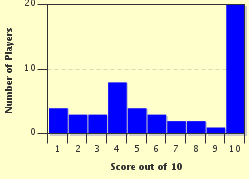Quiz Answer Key and Fun Facts
1. As told in Japanese mythology, the universe existed as a shapeless chaos of particles. How did heaven and Earth first become established?
2. Shapeless deities which formed spontaneously with the heavens in Japanese mythology entrusted Izanagi (a divine male) and Izanami (a divine female) to bring order to Earth. They carried out their early work standing on Amenoukihashi. What was Amenoukihashi?
3. One of the first tasks carried out by Izanagi and Izanami was to create the islands of Japan, which are depicted as deities in their own right. Among these was Yamato, the largest of the islands. By what name is it now known?
4. Following the creation of land, Izanagi and Izanami performed a ritual which signified their marriage. However, the children which resulted from their consummation were sickly and weak. Why was this?
5. Several children were born to Izanagi and Izanami, all of which represented different aspects of nature. What name from Shintoism is given to these beings which inhabit natural phenomena?
6. The labour of Izanami continued and the early Earth in Japanese mythology became more and more complete. The final birth, however, caused Izanami excruciating pain and eventually killed her. What was delivered to the Earth during this final birth?
7. Izanagi attempted unsuccessfully to bring Izanami back from the dead. In the following period of grief, Izanagi created three more children - Amaterasu (the Sun), Tsukiyomi (the Moon), and Susano. What implement did Izanagi supposedly use to create these deities?
8. Amaterasu represented the Sun and Tsukiyomi the Moon. Which of the following is true of the Sun and the Moon in Japanese mythology, distinguishing it from most major Western mythologies?
9. Susano, brother of the Sun and the Moon, proved to be a disruptive influence and so was banished to the underworld, over which he would rule. What name is given to the underworld in Japanese mythology?
10. While trees, mountains, rivers, and metals had been born from Izanami, the Earth still lacked animals and grain. What/who adorned the Earth with these?
Source: Author
doublemm
This quiz was reviewed by FunTrivia editor
looney_tunes before going online.
Any errors found in FunTrivia content are routinely corrected through our feedback system.


